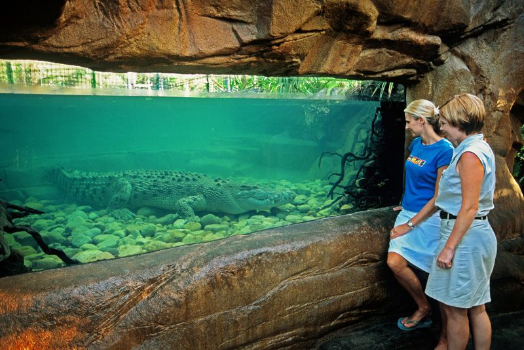


The estuarine crocodile is an ancient species and one which can live a long time - up to 100 years - but many of the oldest and  largest crocs were hunted out by the 1970s. Crocodiles up to 8.4 metres long have been verified in the past but nowadays, most crocs only reach about 5 metres. They are fully protected (including their eggs) and regulated crocodile farms provide controlled products (meat and skins) for domestic and international trade.
largest crocs were hunted out by the 1970s. Crocodiles up to 8.4 metres long have been verified in the past but nowadays, most crocs only reach about 5 metres. They are fully protected (including their eggs) and regulated crocodile farms provide controlled products (meat and skins) for domestic and international trade.
Although the estuarine crocodile (Crocodylus porosus) is not confined to the Wet Tropics, it is by far the best known reptile of tropical north Queensland. For an animal of such power that has existed unchanged over tens of millions of years, the crocodile has had to be protected from its main predator, humans. In turn, humans too, have to be very careful not to fall prey to crocodiles.
You can download a crocwise brochure here about safety in croc country - obey crocodile warning signs, don't go swimming in their habitat and lots of life saving advice.

Crocodiles have some very interesting qualities and capabilities:
You can find out lots more facts and figures in the Tropical Topics about crocodiles.
While this powerful animal can easily tear a large animal apart, it also exhibits the gentlest behaviour with its offspring. The croc builds a mound to incubate its eggs (like the megapodes, the scrub fowl and the brush turkey) and when its 50 or so eggs have hatched and the young have climbed to the surface, the female picks them up in her mouth and carries them carefully down to the water. Males can be predators of their own young but females are very protective and stay close to the mound during the months the eggs are incubating (usually between November and March).
 Viewing crocodiles
Viewing crocodilesThe best and safest place to see crocodiles close-up is at a wildlife park. There are river tours which feature the estuarine crocodile as a drawcard, but it is dependent on the time of year as to whether wild crocodiles will be seen easily. During the wet season temperatures are usually too hot so the crocodiles submerge to the river bottom during the day. However, in the cooler winter months, crocodiles bask on the banks of some rivers to get warm. Some crocs are wary of the sound of boat motors so even the winter visitor might only see the tell-tale slide on the bank (slides are the body and footprint impression left on the muddy bank after a crocodile has darted into the water).
In Cairns, a crocodile removal program is in progress for all areas except the mangrove wetland system adjacent to Trinity Inlet. Estuarine crocodiles are trapped and relocated to crocodile farms or remote areas.